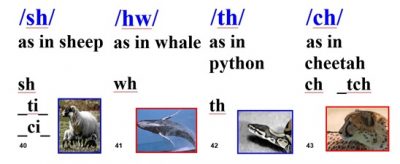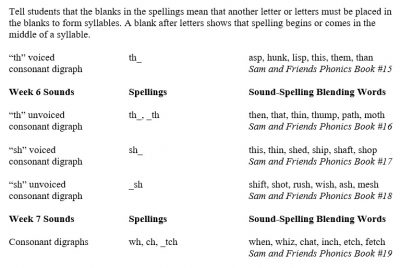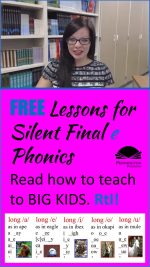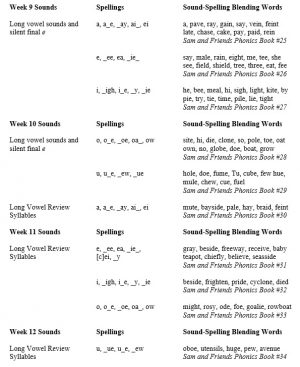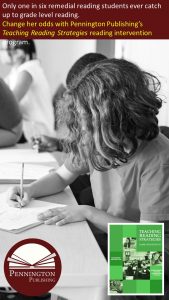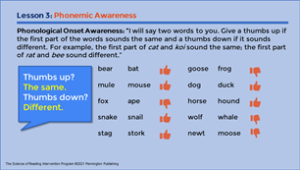Consonant Digraphs for Big Kids
Quite a few new teachers get confused about the difference between consonant digraphs and consonant blends. In a quick Google search, I found plenty of confusion among these “reading experts.” As an MA reading specialist, let me give you the definitions, a way to remember the difference, some examples, a few teaching tips, a FREE whole-class assessment with audio file, an instructional scope and sequence, and instructional management tips. Also, let’s throw in a FREE set of five consonant digraph lessons with a short formative assessment. Wahoo!
Consonant Digraphs
Definition: Consonant digraphs are two (or three) letters which form one sound. Consonant blends are two (or three) letters which make two (or three) sounds.
How to remember the difference: When we are dealing with phonics, we are creating sounds from letters. As you know, phon means sound; so does son (think sonar). You also know that di means two and graph means writing (letters for our purpose). Thus, a consonant digraph is one sound, two letters. Don’t forget we also have vowel digraphs: one vowel sound with two letters.
And now for consonant blends… When you blend spices in your favorite chili recipe, you can still taste the chili powder, salt, cumin, and cayenne pepper. Each spice keeps its individual flavor. Thus, a consonant blend puts together two or three letters, each keeping its own sound. Note: Be careful not to think of a blender regarding consonant blends. My Vitamix® takes away every flavor from every ingredient in my daily protein drink. In other words, each consonant phoneme (speech sound) is retained when decoding the consonant blend spellings.
Consonant Digraph Examples: The “h” Brothers
Teaching Tips
Make sure to teach the breathy /w/ sound for the “wh” digraph. The Middle English pronunciation before the Great Vowel Shift (beginning in about 1350 A.D.) was actually two sounds before they evolved into one. Contrast the /w/ “wh” as in whale with the /w/ “w” as in wolf and you’ll hear the difference. Note: The sound-spelling cards I use in my Teaching Reading Strategies reading intervention program are all animals. Thankfully, there is a critter known as an “x-ray” fish.
Make sure to teach the two sounds of the “th” spellings and “sh” spellings at some point. The differences are difficult to hear for most students (and many teachers). I suggest sticking with the voiced /th/ as in python and then moving to the unvoiced (the same with the “sh” consonant digraph). See the instructional sequence below for the blending sample words I use. Check out my article on “How to Teach the Voiced and Unvoiced ‘th'” if this confuses you.
Do not elongate the endings of consonant digraphs. I just got finished watching a video of a proud principal teaching a group of students the /sh/ consonant digraph. The principal was putting her index finger in front of pursed lips while she said (and had students repeat) “shhhhhhhhhh.” When the principal asked her students to blend the /sh/ + /ĕ/ + /d/, the students dutifully responded with “”shhhhhhhhhhed.” The perplexed principal wisely called on the teacher for help.
Lastly, I don’t teach the “ph” consonant blend until we get to silent letters. It’s a Greek sound-spelling, but then you knew that!
Assessment, Instructional Scope and Sequence, Forming Groups, Time, Instruction, and Practice
The first step is to determine what is missing from the your students’ knowledge of the consonant digraph phonics patterns. Teachers have used my FREE reading assessments for years to pinpoint phonemic awareness, phonics, and sight words deficits. For the purposes of this article, the Consonant Sounds Phonics Assessment pinpoints which consonant digraph sound-spellings students have not yet mastered.
The second step is to follow a research-tested instructional scope and sequence. Most all explicit, systematic phonics programs begin with short vowels and layer on consonant sounds and consonant blends. Next, phonics programs begin with the long vowel sound-spellings or teach the silent final e sound-spellings.
The third step is to group students who have demonstrated that they have not yet achieved mastery with the consonant digraph sound-spellings. Teachers use a variety of small group formats. Literacy centers have become a popular option to provide remedial instruction within some centers (stations), while offering grade-level and/or accelerated instruction in other centers.
The fourth step is to set aside the necessary time to teach the consonant digraph sound-spellings. Initial instruction takes longer; however, remedial instruction can be accomplished quite quickly, because gap-filling builds upon some degree of prior knowledge, albeit a shaky foundation. Typically, five 20-minute workshops will facilitate mastery as indicated by formative assessments.
The fifth step is to provide effective instruction and practice for the consonant digraph sound-spellings and to use a formative assessment to determine mastery. Teachers need to have back-up lessons in case the student does not master the consonant digraphs on the formative assessment. A solid foundation will allow students to learn additional reading skills.

The Science of Reading Intervention Program
The Science of Reading Intervention Program: Word Recognition includes explicit, scripted instruction and practice with the 5 Daily Google Slide Activities every reading intervention student needs: 1. Phonemic Awareness and Morphology 2. Blending, Segmenting, and Spelling 3. Sounds and Spellings (including handwriting) 4. Heart Words Practice 5. Sam and Friends Phonics Books (decodables). Plus, digital and printable sound wall cards and speech articulation songs. Print versions are available for all activities. First Half of the Year Program (55 minutes-per-day, 18 weeks)
The Science of Reading Intervention Program: Language Comprehension resources are designed for students who have completed the word recognition program or have demonstrated basic mastery of the alphabetic code and can read with some degree of fluency. The program features the 5 Weekly Language Comprehension Activities: 1. Background Knowledge Mentor Texts 2. Academic Language, Greek and Latin Morphology, Figures of Speech, Connotations, Multiple Meaning Words 3. Syntax in Reading 4. Reading Comprehension Strategies 5. Literacy Knowledge (Narrative and Expository). Second Half of the Year Program (30 minutes-per-day, 18 weeks)
The Science of Reading Intervention Program: Assessment-based Instruction provides diagnostically-based “second chance” instructional resources. The program includes 13 comprehensive assessments and matching instructional resources to fill in the yet-to-be-mastered gaps in phonemic awareness, alphabetic awareness, phonics, fluency (with YouTube modeled readings), Heart Words and Phonics Games, spelling patterns, grammar, usage, and mechanics, syllabication and morphology, executive function shills. Second Half of the Year Program (25 minutes-per-day, 18 weeks)
The Science of Reading Intervention Program BUNDLE includes all 3 program components for the comprehensive, state-of-the-art (and science) grades 4-adult full-year program. Scripted, easy-to-teach, no prep, no need for time-consuming (albeit valuable) LETRS training or O-G certification… Learn as you teach and get results NOW for your students. Print to speech with plenty of speech to print instructional components.
Get the SCRIP Comprehension Strategies FREE Resource:
![]()
Get the Diagnostic ELA and Reading Assessments FREE Resource:

